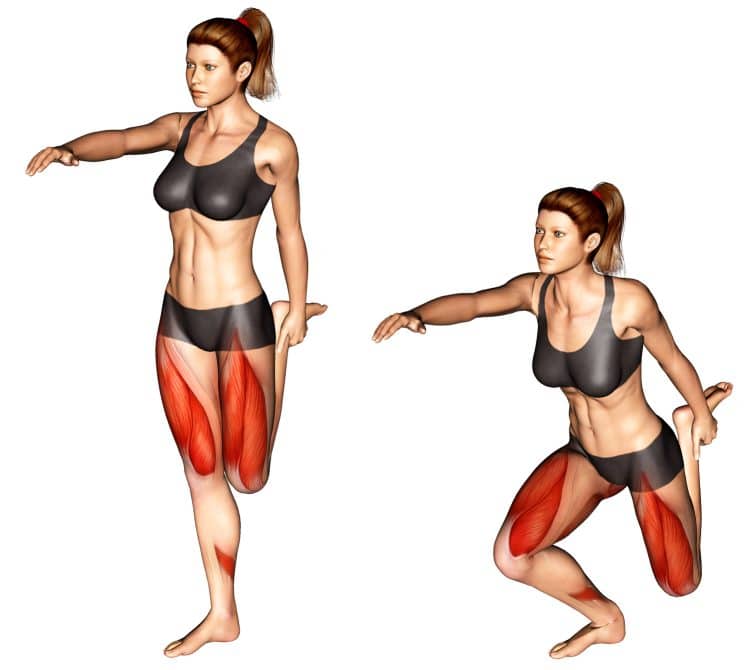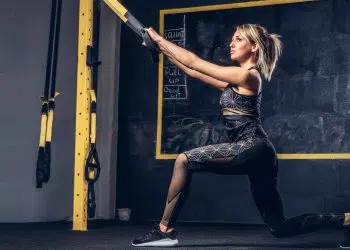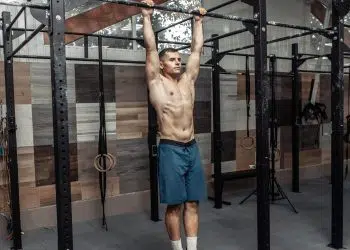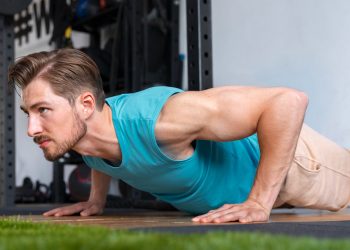When it comes to pure workout convenience, calisthenics or bodyweight training is hard to beat. All you really need is some floor space, a pull-up bar, and maybe some parallel bars for dips, and you have all you need to train every muscle in your body.
With progressive calisthenics, you can build muscle, get strong, burn fat, and improve athleticism without stepping foot in a gym. Variations of pull-ups, push-ups, and dips can help develop your chest, back, shoulders, and arms, while squats and lunges are great lower body exercises.
But there is a downside to calisthenics – many lower body exercises are just too easy to be effective. After all, if you can do 10 to 12 reps with 220 pounds in back squats, you’ll probably have no problem cranking out sets of 50 or more bodyweight squats. High reps can be challenging, but they’re not the best use of your training time.
This is where unilateral or single-limb training comes in. For example, switching from squats to lunges puts more weight on one leg. However, even this progression probably won’t be sufficient as you get stronger.
This leaves true unilateral leg exercises like pistols, AKA single leg squats. Unfortunately, it’s a big step up from squats and lunges to unilateral pistols. A poorly performed pistol is an injury waiting to happen.
Shrimp squats are a more manageable single-leg exercise. In this article, we reveal why and how to do shrimp squats and explain the best variations and alternatives.
Level Up Your Fitness: Join our 💪 strong community in Fitness Volt Newsletter. Get daily inspiration, expert-backed workouts, nutrition tips, the latest in strength sports, and the support you need to reach your goals. Subscribe for free!
Shrimp Squats – Muscles Worked
The shrimp squat, also known as skater squats, is a compound leg exercise. This means it involves movement at two or more joints and several muscles at the same time. In fact, the shrimp squat works virtually every muscle in your lower body.

That said, the main muscles trained by shrimp squats include:
- Quadriceps – located at the front of your thighs, the quadriceps extend your knee and flex your hip. Known as the quads for short, the four muscles that make up this group are the vastus lateralis, vastus intermedius, vastus medialis, and rectus femoris.
- Hamstrings – the hamstrings flex your knee and extend your hip. There are three hamstring muscles; the biceps femoris, semimembranosus, and semitendinosus. The deeper you squat, the more active your hamstrings will be.
- Abductors – located on the outside of your hips and thighs, the abductors lift your leg out and away from the midline of your body. In shrimp squats, these muscles work hard to stabilize your hips and stop your knees from falling inward. The abductors include the gluteus medius, gluteus minimus, and the tensor fascia latae.
- Adductors – opposing the abductors, the adductors pull your legs into the midline of your body. During shrimp squats, the adductors prevent your knees from falling outward. The three adductors are longus, brevis, and magnus, meaning longest, shortest, and thickest, and are located on the inside of your thigh.
- Gastrocnemius and soleus – these muscles make up your calves. Balancing on one leg increases calf activation as these muscles must work to stabilize your knee and ankle. However, this is a relatively indirect effect, so you may not feel your calves working all that much.
- Core – this is the collective term for the muscles of your midsection, including the rectus abdominis, obliques, transverse abdominis, and erector spinae. Surrounding your waist like a muscular weightlifting belt, the core muscles contract inward to stabilize your lumbar spine during shrimp squats. However, unless you perform this exercise with an added load, core engagement is relatively low.
How to Do Shrimp Squats
Get more from shrimp squats while keeping your risk of injury to a minimum by following these guidelines:
- Stand with your feet together, arms by your sides. Pull your shoulders down and back and look straight ahead.
- Bend one leg and pull your foot up to your butt. Grab your ankle with the same side hand.
- Extend your other arm out in front of you for balance. Clench your fist to create tension throughout your body.
- Bend your supporting leg and descend until your other knee lightly touches the floor.
- You can protect your rear knee by placing a folded mat or foam pad on the floor, so you won’t touch down too hard.
- Drive your foot into the floor and stand back up.
- Continue for the required number of reps and then switch sides. Try to do the same number of reps on each leg.
Shrimp Squat Benefits
Not sure if shrimp squats are the right calisthenic leg exercise for you? Consider these benefits and then decide!
No equipment required – shrimp squats are the perfect excuse-free leg exercise. All you need is a couple of square feet of space. You can do this exercise anywhere and anytime, even in a bare prison cell or hotel room.
Plenty of overload – if you are used to doing regular bodyweight squats and lunges, shrimp squats should provide plenty of overload for your glutes, quads, and hamstrings. After all, you’re going to go from lifting your bodyweight with two legs to lifting it with one. This should provide more than enough resistance to challenge your muscles and build strength.
Good for balance and mobility – while not as technically demanding as pistols, the shrimp squat will still challenge and improve your balance and mobility. As such, this is an excellent exercise for athletes and anyone who wants to develop functional strength.
Identify and fix left to right strength imbalances – most people have one leg stronger than the other. But, if this imbalance is allowed to become too wide, injuries are often the result. Doing shrimp squats can reveal any strength imbalances and also provide the means to fix any problems before they become more severe.
Shrimp Squat Drawbacks
While shrimp squats are a mostly safe and beneficial exercise, there are also a few drawbacks to consider.
Lack of skill may undermine your workouts – while shrimp squats are significantly easier than the more technically challenging pistol squat, they’re still considerably harder than squats and lunges.
If you have poor balance or lack mobility, you may not be able to do full shrimp squats. However, there are modifications that will make this exercise more manageable, which are outlined below.
Limited progression – working with your bodyweight is a double-edged sword. On the one hand, it means that you can train anywhere and anytime. But, on the downside, it can make progressing your workouts more difficult.
Yes, you CAN do more reps per set, but eventually, this form of progression will cease to be effective. So, you may need to learn how to do shrimp squats with additional weight to stop them from becoming redundant.
Knee pain – there is a large stability demand to shrimp squats, and it’s not uncommon for the knee joint to wobble during this exercise. Lateral and rotational stress on the joint can result in knee pain. Eliminate this by doing one of the supported/assisted variations outlined below and taking your shoes off and shrimp squatting barefoot. This should help make balancing easier.
7 Shrimp Squat Variations and Alternatives
Shrimp squats are a highly effective calisthenic lower body exercise, but that doesn’t mean you need to do them all the time. There are several variations and alternatives you can use to keep your leg workouts productive and interesting:
Level Up Your Fitness: Join our 💪 strong community in Fitness Volt Newsletter. Get daily inspiration, expert-backed workouts, nutrition tips, the latest in strength sports, and the support you need to reach your goals. Subscribe for free!
1. Assisted Shrimp Squat
This is an excellent variation for anyone struggling with balance or the muscular demands of shrimp squats. With this variation, you get to use your free arm for assistance.
Try not to rely too heavily on your arm, but instead, only use it just enough to be able to complete your reps. Work on weaning yourself off this additional support as you get stronger. Your aim is to do shrimp squats unaided.
How to do it:
- Stand with your feet together, arms by your sides. Pull your shoulders down and back and look straight ahead.
- Bend one leg and pull your foot up to your butt. Grab your ankle with the same side hand. Extend your other arm out in front of you and grab a post, squat rack, or a suspension trainer handle.
- Using your arm for balance, bend your supporting leg and descend until your other knee lightly touches the floor.
- Drive your foot into the floor and stand back up.
- Continue for the required number of reps and then switch sides.
2. Shrimp Squat to Box
If you find it too challenging to lower your knee to the floor, place a low step or box next to/behind you and lower your knee to that instead. Squatting to a box reduces your range of motion and makes the shrimp squat much easier to manage.
This is an ideal regression for beginners and those with poor mobility. Graduate to a lower box as your form improves, progressing to doing shrimp squats to the floor when you are ready.
How to do it:
- Stand on one leg and pull your foot into your butt. Your bent knee should be directly over your raised box. The higher the box, the shorter your range of motion will be, and the easier the exercise becomes.
- Using your arm for balance if required, bend your supporting leg and descend until your other knee lightly touches the box.
- Drive your foot into the floor and stand back up.
- Continue for the required number of reps and then switch sides.
- Reduce the height of the box as you become more proficient.
3. Deficit Shrimp Squat
With regular shrimp squats, your range of movement is limited by your rearmost knee touching the floor. With this variation, you stand on a raised platform so you can descend into a deeper squat for a more demanding workout without adding weight.
How to do it:
- Stand on a four to six-inch high platform, e.g., an aerobics step or a couple of bumper plates.
- Bend one leg and pull your foot up to your butt. Grab your ankle with the same side hand.
- Extend your other arm out in front of you for balance. Alternatively, you can do this exercise using your free arm for assistance.
- Bend your supporting leg and descend until your other knee lightly touches the floor.
- Drive your foot into the floor and stand back up.
- Continue for the required number of reps and then switch sides. Try to do the same number of reps on each leg.
4. Loaded Shrimp Squat
Sometimes, the most straightforward way to make any exercise harder is to increase the weight. With shrimp squats, you can do this by wearing a weighted vest, holding a weight by your side, or up at shoulder height.
As you are already lifting your entire body weight with just one leg, you won’t need a lot of extra external load to make shrimp squats considerably more demanding. Depending on how or where you hold the weight, you may need to do loaded shrimp squats without holding your back leg.
5. Bulgarian Split Squat
Also known as the rear foot elevated split squat, the Bulgarian split squat is very similar to the shrimp squat. However, this variation allows you to use your back leg for balance and assistance, so it’s a little easier. That said, the Bulgarian split squat is still a good progression from regular squats and lunges.
How to do it:
- Stand with your back to a knee-high bench. Bend one leg and place the top of your foot on the benchtop. Hop forward into a split stance, stand up straight, and look ahead.
- Bend your legs and lower your rear knee down to lightly touch the floor. Most of your weight should be on your front leg. Only use your back leg for assistance.
- You can protect your rear knee by placing a folded mat or foam pad on the floor, so you won’t touch down too hard.
- Drive your foot into the floor, stand back up, and repeat.
- Rest a moment, and then do the same number of reps with the opposite leg.
6. Suspension Trainer/Rings Bulgarian Split Squat
Using a suspension trainer, such as a TRX, introduces an element of instability to your leg workout. This increases muscle activation and also makes the exercise considerably harder. You can also do this exercise with a single gymnastic ring.
How to do it:
- Set your suspension trainer to about knee height. With your back to the anchor point, bend one leg and place your foot in the foothold. Your thighs should be roughly together.
- Bend your front leg, extend your other leg behind you, and descend until your rear knee lightly brushes the floor.
- Return to the starting position and repeat.
- Rest a moment, and then swap legs. Try to do the same number of reps on each leg.
- This exercise can also be done with additional weights, i.e., dumbbells by your sides or a kettlebell in front of your chest.
7. Pistol Squat
If you are nailing the shrimp squat and craving an even more demanding single-leg calisthenic exercise, it’s time to try pistols. With this move, you extend your non-working leg out in front of you, which requires excellent mobility and balance.
This pistol squat is a tricky exercise, and it’s beyond the scope of this article to explain how to do it. However, you’ll find an in-depth guide to pistol squats here. But, make sure you’ve mastered shrimp squats before attempting this far more demanding movement.
Shrimp Squats – Wrapping Up
A lot of calisthenic athletes have skinny legs. That’s hardly surprising given how hard most upper body calisthenic exercises are, but how easy the leg moves tend to be. There is a big difference in intensity between upper and lower body calisthenic exercises.
As the meme says, friends don’t let friends skip leg day, so make sure you don’t leave your lower body out of your workouts, even if you focus primarily on bodyweight training.
Shrimp squats and other unilateral leg exercises provide an effective way to overload your legs without resorting to using barbells or dumbbells. It can be a big step up from bilateral to unilateral bodyweight leg exercises. But, providing you progress logically and gradually, you should be able to work all the way up to pistols via shrimp and Bulgarian split squats in a matter of months.
Interested in measuring your progress? Check out our strength standards for Push Ups, Bulgarian Split Squat, Bodyweight Squat, and more.











